 There
are some Springboard modules for the Visor that really show just how "cool"
the Visor is. One of these modules, the eyemodule by IDEO, allows
you to take simple pictures wherever you go.
There
are some Springboard modules for the Visor that really show just how "cool"
the Visor is. One of these modules, the eyemodule by IDEO, allows
you to take simple pictures wherever you go.
Brief Description: There are
some Springboard modules for the Visor that really show just how "cool"
the Visor is. One of these modules, the eyemodule by IDEO, allows
you to take simple pictures wherever you go. Read the review where
I take the eyemodule to an Astros game at Enron Field.
Product Details
Name: eyemodule
Company: IDEO
Size: 2.8125" x 2.125" x
0.625"
Weight: 1.1 oz.
Memory:
48K on Visor when inserted
Hard Cover Compatible: No
Price: $149.00
 There
are some Springboard modules for the Visor that really show just how "cool"
the Visor is. One of these modules, the eyemodule by IDEO, allows
you to take simple pictures wherever you go.
There
are some Springboard modules for the Visor that really show just how "cool"
the Visor is. One of these modules, the eyemodule by IDEO, allows
you to take simple pictures wherever you go.
Physical Specifications
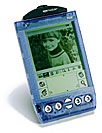 If
you want to impress your friends, take the eyemodule out of your Visor
and tell them it's a digital camera, put it into your Visor and give them
a demo. When the eyemodule is inserted into the Visor, it adds only
15 mm to its length and does not add anything to the Visor's depth.
You will feel a difference in the Visor's weight as the eyemodule weighs
1.1 oz, but this is nothing compared to carrying around a digital camera
with you. The hard cover that comes with the Visor will not work
while the eyemodule is inserted, so cases like the RhinoPak
2000 will need to carry the eyemodule in one of the pockets.
The eyemodule's label is non-intrusive and will not deter from the overall
look of the Visor, especially if you have the graphite Visor. The
eyemodule comes in any color you want, as long as it's graphite.
If
you want to impress your friends, take the eyemodule out of your Visor
and tell them it's a digital camera, put it into your Visor and give them
a demo. When the eyemodule is inserted into the Visor, it adds only
15 mm to its length and does not add anything to the Visor's depth.
You will feel a difference in the Visor's weight as the eyemodule weighs
1.1 oz, but this is nothing compared to carrying around a digital camera
with you. The hard cover that comes with the Visor will not work
while the eyemodule is inserted, so cases like the RhinoPak
2000 will need to carry the eyemodule in one of the pockets.
The eyemodule's label is non-intrusive and will not deter from the overall
look of the Visor, especially if you have the graphite Visor. The
eyemodule comes in any color you want, as long as it's graphite. ![]()
To take pictures, hold the Visor horizontally and point it to your target while aiming, using the Visor's screen as a viewfinder. Snap photos using the button on the right side of the eyemodule, then press the Up button on the Visor to keep the image or the Down button to discard the image. You can also press the Up button to snap a photo.
Usability
When you insert the eyemodule, there is an initial splash screen and then the Visor turns into a viewfinder for any photos that you take. Then When files are synced, your images become .jpg files in the default name of dd_mm_yy_hh_mm_ss_am/pm.jpg, and by default are placed in C:\eyemodule\<username>. The eyemodule is not required to be in the Visor when transfering images to your desktop.
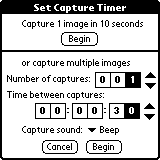 There
are a surprising number of options that comes with the eyemodule software.
You can take images in three different formats:
There
are a surprising number of options that comes with the eyemodule software.
You can take images in three different formats:
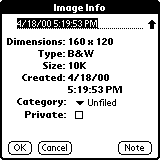 The
button to the right of the Viewfinder is to
view your images. Press the Up/Down
button to move among your photos when you have one on screen. Here
you can also zoom in on any 320x240 image, beam it to someone, and pull
up the information on the image. On the Information
screen you can change the name of the image, modify its category, add a
note, or mark it private. I really like the fact that I can beam
the eyemodule application to someone, and
then beam any pictures to that person. The eyemodule
app, along with any pictures, stays on the Visor even when the eyemodule
is not in the Springboard slot.
The
button to the right of the Viewfinder is to
view your images. Press the Up/Down
button to move among your photos when you have one on screen. Here
you can also zoom in on any 320x240 image, beam it to someone, and pull
up the information on the image. On the Information
screen you can change the name of the image, modify its category, add a
note, or mark it private. I really like the fact that I can beam
the eyemodule application to someone, and
then beam any pictures to that person. The eyemodule
app, along with any pictures, stays on the Visor even when the eyemodule
is not in the Springboard slot.
Next to the Viewer button is the Image List, where you can delete a single image or an entire category. On the Preferences screen, you can set defaults for image format, default category, and whether to backup the images that are taken.
So how well do the pictures look? It depends on the situation. Because there is no flash, you will need a lot of light for decent color photo; greyscale pictures seem to do better when there isn't much light. In these photos of our kitten, Sabrina looks fine in greyscale, although the picture is a little grainy. The color photo of Sabrina has very little color in it because the lighting in our home isn't the greatest.
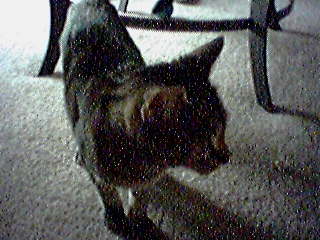
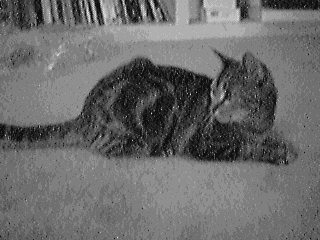
I wanted to get some good examples of daytime/nightime photos, so what better way than to go watch an Astros game outside at Enron Field! The daytime pictures look pretty good, although they are a little fuzzy. The text from the scoreboard is very easy to read with the naked eye but is difficult to make out in these photos. The sky, however, looks great, and the late afternoon photo shows a good range of colors as the sun begins to go down.
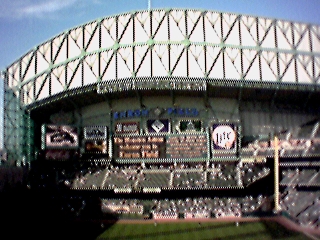
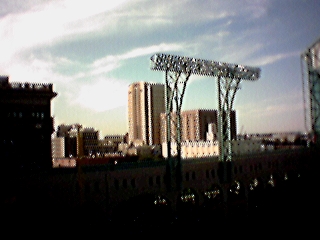
Nightime photos of the scoreboard were worse. The words "Enron Field" are the only lighted words that can be read in the photos. Any lights in the pictures are blurred together, making it impossible to ready any lighted text. There isn't much color differentiation, and the players look extremely tiny on the field, when they can actually be easily seen. The one thing that this eyemodule sorely lacks is a flashbulb.
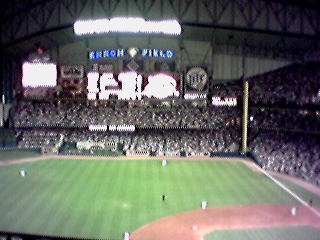
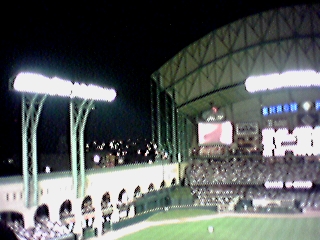
Looking at these pictures, the eyemodule
may not look too hot, but that depends on your intent. If you are
planning to take professional looking photos or will be photographing in
poor lighting, the eyemodule is not for you. My favorite thing about
the eyemodule is its "coolness" factor. Every time I take it out
in public for test shots or to show a friend, it definitely draws a crowd.
When I took the photos at Enron Field, I ended up showing an usher the
camera. When I showed it to some classmates at college, the professor
was so interested in the Visor that she wrote down Handspring
and asked if it was traded publicly. ![]() You could also use the eyemodule to take photos of whiteboards, although
you will need to be very close to them to take a clear picture --
otherwise, your photo will be entirely white.
You could also use the eyemodule to take photos of whiteboards, although
you will need to be very close to them to take a clear picture --
otherwise, your photo will be entirely white.
I also like the small size of the
eyemodulel, especially in comparison with a normal digital camera.
It is, however, too large to be inside the Rhodiana
Visor Case or the E&B
Slipper Visor. It will however, fit in the Otter
Box 2000, the RhinoPak
1100, and the RhinoPak
2000, although you won't be able to strap it against the Visor hard
cover in the Rhino cases. The diminutive size of the eyemodule makes
it seem like the kind of camera James Bond would use, and the eyemodule
could probably be used to take secret photos if the lighting was good enough.
(I hope to one day get a chance to test this theory ![]() )
But the eyemodule is best suited for impromptu photos of our everyday lives.
Luckily enough, the conduit saves photos to your computer -- this means
you can then e-mail all of those wonderful impromptu shots to your friends!
)
But the eyemodule is best suited for impromptu photos of our everyday lives.
Luckily enough, the conduit saves photos to your computer -- this means
you can then e-mail all of those wonderful impromptu shots to your friends!
Conclusion
If you can handle the high price and want to show off how cool your Visor really is, the eyemodule is a great way to do it. It doesn't take high quality pictures, but its small formfactor makes the eyemodule easier to take with you than a normal camera.
Criteria
Features 3
Usability 4
Setup 5
Cost/Benefit 2
VisorCentral
Rating : ![]()
![]()
![]()
Pros
- Small formfactor
- Easy to
use
Cons
- Low resolution
- Images are
fuzzy
- Needs good
lighting